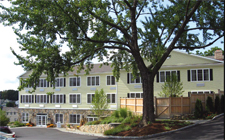
A home in West Islip, the Long Island town most likely to be impacted by hurricanesLong Island
Coastline is largest hurricane risk in area
A recent report on 10 coastal metro areas found that Long Island has the most residential property at risk of hurricane damage, according to the Long Island Press.
CoreLogic, the private real estate firm that conducted the research, found that Long Island faces $99 billion in potential damage from hurricanes.
The report noted that damage could be done to 250,000 properties on Long Island if a Category 4 hurricane hit. (Most meteorologists agree that the area’s cool waters make a Category 5 storm, the biggest possible, highly unlikely.)
Even a Category 1 storm could cause $32.1 billion worth of damage to almost 74,000 residential properties on the Island, the report said. West Islip would be most affected by a hurricane, followed by Massapequa, Riverhead, the Flatlands in Brooklyn (which is geographically part of Long Island), Bay Shore, East Islip, Sheepshead Bay in Brooklyn, Merrick and Cutchogue.
The report also concluded that the majority of homes at risk are not located in federally defined flood zones. Only 21.8 percent of the at-risk properties on Long Island are located within surge and flood zones.
Westchester
Tax appeals soar
Local governments in Westchester County are being bombarded with property-tax appeals, the New York Times reported.
The number of tax grievances in the county nearly quintupled between 2008 and 2010, according to the Times. The county, which has both high taxes and antiquated tax rolls, has seen a growing number of companies offering to seek reductions in homeowners’ tax bills in exchange for a share of the savings.
In Greenburgh, for example, Long Island-based Assessment Correction Group filed 471 grievances in 2010 after setting up shop in Westchester the previous year. Meanwhile, 703 taxpayers filed grievances on their own in 2010, up from 449 in 2009.
“Now that the economy’s so bad, people are saying, ‘If I can get away with it, I’m going to challenge my taxes,'” Paul Feiner, Greenburgh’s town supervisor, told the Times.
The deluge of grievances is swamping local assessors, who must defend against scores of appeals. Meanwhile, a backlog of cases is exacerbating municipal fiscal problems, as towns may become liable to pay future tax refunds without being able to accurately budget for them.
 Maplewood’s new assisted-livingfacility in Danbury, Conn.
Maplewood’s new assisted-livingfacility in Danbury, Conn.
Connecticut
Local assisted-living centers on the rise
More assisted-living facilities are appearing in Connecticut and throughout the New York City metro area, according to the Wall Street Journal.
While new office buildings are rare in the still-struggling economy, developers are moving ahead with assisted-living facilities, a cross between apartment buildings and nursing homes.
The New York City area currently has the second-fewest assisted-living units in the country, with growth of only 3 percent — below the national average of 7.4 percent, according to the National Investment Center for the Seniors Housing & Care Industry.
Maplewood Communities, for example, in 2004 bought a failed nursing home in Danbury for $11.5 million, and converted it into an assisted-living community. Its value is now some $18 million, company head Greg Smith told the Journal. Smith has since built two other communities in Connecticut.
